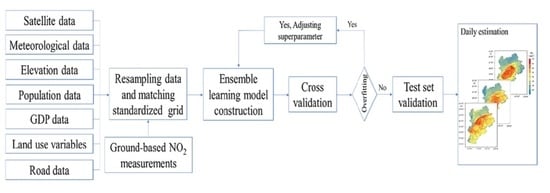Estimating the Daily NO2 Concentration with High Spatial Resolution in the Beijing–Tianjin–Hebei Region Using an Ensemble Learning Model
Abstract
1. Introduction
2. Materials and Methods
2.1. Study Area
2.2. Datasets
2.2.1. Ground-Based NO2 Measurements
2.2.2. Satellite Data
2.2.3. Meteorological Data
2.2.4. Elevation Data, Population Data, and Gross Domestic Product (GDP) Data
2.2.5. Land-Use Data
2.2.6. Road Network Data
2.3. Data Processing
2.4. Modeling
2.5. Validation
3. Results
3.1. Descriptive Analysis
3.2. Importance Percentage of Predictor Variables
3.3. Temporal Performance
3.4. Spatial Performance
3.5. Spatial and Temporal Distribution
4. Discussion
4.1. Comparsion with other NO2 Models
4.2. Predicator Variable Selection
4.3. Spatial and Temporal Distribution
4.4. Advantages and Limitations
5. Conclusions
Supplementary Materials
Author Contributions
Funding
Acknowledgments
Data Availability Statement
Conflicts of Interest
References
- Hao, J.; Wu, Y.; Fu, L.; He, D.; He, K. Source contributions to ambient concentrations of CO and NOX in the urban area of Beijing. J. Environ. Sci Health A Tox Hazard. Subst Environ. Eng. 2001, 36, 215–228. [Google Scholar] [CrossRef]
- Krotkov, N.A.; McLinden, C.A.; Li, C.; Lamsal, L.N.; Celarier, E.A.; Marchenko, S.V.; Swartz, W.H.; Bucsela, E.J.; Joiner, J.; Duncan, B.N.; et al. Aura OMI observations of regional SO2 and NO2 pollution changes from 2005 to 2015. Atmos. Chem. Phys. 2016, 16, 4605–4629. [Google Scholar] [CrossRef]
- van der A, R.J.; Mijling, B.; Ding, J.; Koukouli, M.E.; Liu, F.; Li, Q.; Mao, H.; Theys, N. Cleaning up the air: Effectiveness of air quality policy for SO2 and NOx emissions in China. Atmos. Chem. Phys. 2017, 17, 1775–1789. [Google Scholar] [CrossRef]
- Goldstein, I.F.; Lieber, K.; Andrews, L.R.; Kazembe, F.; Foutrakis, G.; Huang, P.; Hayes, C. Acute respiratory effects of short-term exposures to nitrogen dioxide. Arch. Environ. Health 1988, 43, 138–142. [Google Scholar] [CrossRef] [PubMed]
- Chen, R.; Samoli, E.; Wong, C.M.; Huang, W.; Wang, Z.; Chen, B.; Kan, H.; Group, C.C. Associations between short-term exposure to nitrogen dioxide and mortality in 17 Chinese cities: The China Air Pollution and Health Effects Study (CAPES). Environ. Int. 2012, 45, 32–38. [Google Scholar] [CrossRef]
- Faustini, A.; Rapp, R.; Forastiere, F. Nitrogen dioxide and mortality: Review and meta-analysis of long-term studies. Eur. Respir. J. 2014, 44, 744–753. [Google Scholar] [CrossRef]
- Mills, I.C.; Atkinson, R.W.; Kang, S.; Walton, H.; Anderson, H.R. Quantitative systematic review of the associations between short-term exposure to nitrogen dioxide and mortality and hospital admissions. BMJ Open 2015, 5, e006946. [Google Scholar] [CrossRef] [PubMed]
- Geddes, J.A.; Martin, R.V.; Boys, B.L.; van Donkelaar, A. Long-Term Trends Worldwide in Ambient NO2 Concentrations Inferred from Satellite Observations. Environ. Health Perspect. 2016, 124, 281–289. [Google Scholar] [CrossRef] [PubMed]
- Bechle, M.J.; Millet, D.B.; Marshall, J.D. National Spatiotemporal Exposure Surface for NO2: Monthly Scaling of a Satellite-Derived Land-Use Regression, 2000–2010. Environ. Sci. Technol. 2015, 49, 12297–12305. [Google Scholar] [CrossRef] [PubMed]
- Larkin, A.; Geddes, J.A.; Martin, R.V.; Xiao, Q.; Liu, Y.; Marshall, J.D.; Brauer, M.; Hystad, P. Global Land Use Regression Model for Nitrogen Dioxide Air Pollution. Environ. Sci. Technol. 2017, 51, 6957–6964. [Google Scholar] [CrossRef]
- Yang, X.; Zheng, Y.; Geng, G.; Liu, H.; Man, H.; Lv, Z.; He, K.; de Hoogh, K. Development of PM2.5 and NO2 models in a LUR framework incorporating satellite remote sensing and air quality model data in Pearl River Delta region, China. Environ. Pollut. 2017, 226, 143–153. [Google Scholar] [CrossRef]
- Gonzales, M.; Myers, O.; Smith, L.; Olvera, H.A.; Mukerjee, S.; Li, W.W.; Pingitore, N.; Amaya, M.; Burchiel, S.; Berwick, M.; et al. Evaluation of land use regression models for NO2 in El Paso, Texas, USA. Sci. Total Environ. 2012, 432, 135–142. [Google Scholar] [CrossRef]
- de Hoogh, K.; Saucy, A.; Shtein, A.; Schwartz, J.; West, E.A.; Strassmann, A.; Puhan, M.; Roosli, M.; Stafoggia, M.; Kloog, I. Predicting Fine-Scale Daily NO2 for 2005–2016 Incorporating OMI Satellite Data Across Switzerland. Environ. Sci. Technol. 2019, 53, 10279–10287. [Google Scholar] [CrossRef]
- Qin, K.; Rao, L.; Xu, J.; Bai, Y.; Zou, J.; Hao, N.; Li, S.; Yu, C. Estimating Ground Level NO2 Concentrations over Central-Eastern China Using a Satellite-Based Geographically and Temporally Weighted Regression Model. Remote Sens. 2017, 9, 950. [Google Scholar] [CrossRef]
- Alahmadi, S.; Al-Ahmadi, K.; Almeshari, M. Spatial variation in the association between NO2 concentrations and shipping emissions in the Red Sea. Sci. Total Environ. 2019, 676, 131–143. [Google Scholar] [CrossRef]
- Liu, Z.; Guan, Q.; Luo, H.; Wang, N.; Pan, N.; Yang, L.; Xiao, S.; Lin, J. Development of land use regression model and health risk assessment for NO2 in different functional areas: A case study of Xi’an, China. Atmos. Environ. 2019, 213, 515–525. [Google Scholar] [CrossRef]
- Di, Q.; Amini, H.; Shi, L.; Kloog, I.; Silvern, R.; Kelly, J.; Sabath, M.B.; Choirat, C.; Koutrakis, P.; Lyapustin, A.; et al. Assessing NO2 Concentration and Model Uncertainty with High Spatiotemporal Resolution across the Contiguous United States Using Ensemble Model Averaging. Environ. Sci. Technol. 2020, 54, 1372–1384. [Google Scholar] [CrossRef] [PubMed]
- Zhan, Y.; Luo, Y.; Deng, X.; Zhang, K.; Zhang, M.; Grieneisen, M.L.; Di, B. Satellite-Based Estimates of Daily NO2 Exposure in China Using Hybrid Random Forest and Spatiotemporal Kriging Model. Environ. Sci. Technol. 2018, 52, 4180–4189. [Google Scholar] [CrossRef] [PubMed]
- Qin, K.; Han, X.; Li, D.; Xu, J.; Loyola, D.; Xue, Y.; Zhou, X.; Li, D.; Zhang, K.; Yuan, L. Satellite-based estimation of surface NO2 concentrations over east-central China: A comparison of POMINO and OMNO2d data. Atmos. Environ. 2020, 224, 117322. [Google Scholar] [CrossRef]
- Araki, S.; Shima, M.; Yamamoto, K. Spatiotemporal land use random forest model for estimating metropolitan NO2 exposure in Japan. Sci. Total Environ. 2018, 634, 1269–1277. [Google Scholar] [CrossRef]
- Chen, Z.Y.; Zhang, R.; Zhang, T.H.; Ou, C.Q.; Guo, Y. A kriging-calibrated machine learning method for estimating daily ground-level NO2 in mainland China. Sci. Total Environ. 2019, 690, 556–564. [Google Scholar] [CrossRef] [PubMed]
- Wang, M.; Beelen, R.; Eeftens, M.; Meliefste, K.; Hoek, G.; Brunekreef, B. Systematic evaluation of land use regression models for NO2. Environ. Sci. Technol. 2012, 46, 4481–4489. [Google Scholar] [CrossRef]
- Su, J.G.; Brauer, M.; Ainslie, B.; Steyn, D.; Larson, T.; Buzzelli, M. An innovative land use regression model incorporating meteorology for exposure analysis. Sci. Total Environ. 2008, 390, 520–529. [Google Scholar] [CrossRef] [PubMed]
- Lee, H.J.; Koutrakis, P. Daily ambient NO2 concentration predictions using satellite ozone monitoring instrument NO2 data and land use regression. Environ. Sci. Technol. 2014, 48, 2305–2311. [Google Scholar] [CrossRef] [PubMed]
- Hoek, G.; Eeftens, M.; Beelen, R.; Fischer, P.; Brunekreef, B.; Boersma, K.F.; Veefkind, P. Satellite NO2 data improve national land use regression models for ambient NO2 in a small densely populated country. Atmos. Environ. 2015, 105, 173–180. [Google Scholar] [CrossRef]
- Young, M.T.; Bechle, M.J.; Sampson, P.D.; Szpiro, A.A.; Marshall, J.D.; Sheppard, L.; Kaufman, J.D. Satellite-Based NO2 and Model Validation in a National Prediction Model Based on Universal Kriging and Land-Use Regression. Environ. Sci. Technol. 2016, 50, 3686–3694. [Google Scholar] [CrossRef]
- Lee, J.H.; Wu, C.F.; Hoek, G.; de Hoogh, K.; Beelen, R.; Brunekreef, B.; Chan, C.C. Land use regression models for estimating individual NOx and NO2 exposures in a metropolis with a high density of traffic roads and population. Sci. Total. Environ. 2014, 472, 1163–1171. [Google Scholar] [CrossRef]
- Xiao, Q.; Chang, H.H.; Geng, G.; Liu, Y. An Ensemble Machine-Learning Model To Predict Historical PM2.5 Concentrations in China from Satellite Data. Environ. Sci. Technol. 2018, 52, 13260–13269. [Google Scholar] [CrossRef] [PubMed]
- Zhan, Y.; Luo, Y.; Deng, X.; Grieneisen, M.L.; Zhang, M.; Di, B. Spatiotemporal prediction of daily ambient ozone levels across China using random forest for human exposure assessment. Environ. Pollut. 2018, 233, 464–473. [Google Scholar] [CrossRef]
- Chen, Z.-Y.; Zhang, T.-H.; Zhang, R.; Zhu, Z.-M.; Yang, J.; Chen, P.-Y.; Ou, C.-Q.; Guo, Y. Extreme gradient boosting model to estimate PM2.5 concentrations with missing-filled satellite data in China. Atmos. Environ. 2019, 202, 180–189. [Google Scholar] [CrossRef]
- Beloconi, A.; Vounatsou, P. Bayesian geostatistical modelling of high-resolution NO2 exposure in Europe combining data from monitors, satellites and chemical transport models. Environ. Int. 2020, 138, 105578. [Google Scholar] [CrossRef]
- Li, R.; Cui, L.; Liang, J.; Zhao, Y.; Zhang, Z.; Fu, H. Estimating historical SO2 level across the whole China during 1973-2014 using random forest model. Chemosphere 2020, 247, 125839. [Google Scholar] [CrossRef] [PubMed]
- Requia, W.J.; Di, Q.; Silvern, R.; Kelly, J.T.; Koutrakis, P.; Mickley, L.J.; Sulprizio, M.P.; Amini, H.; Shi, L.; Schwartz, J. An Ensemble Learning Approach for Estimating High Spatiotemporal Resolution of Ground-Level Ozone in the Contiguous United States. Environ. Sci. Technol. 2020, 54, 11037–11047. [Google Scholar] [CrossRef] [PubMed]
- Zhao, C.; Wang, Q.; Ban, J.; Liu, Z.; Zhang, Y.; Ma, R.; Li, S.; Li, T. Estimating the daily PM2.5 concentration in the Beijing-Tianjin-Hebei region using a random forest model with a 0.01°×0.01° spatial resolution. Environ. Int. 2020, 134, 105297. [Google Scholar] [CrossRef] [PubMed]
- Krotkov, N.A.; Lamsal, L.N.; Marchenko, S.V.; Celarier, E.A.; Bucsela, E.J.; Swartz, W.H.; Joanna Joiner and the OMI Core Team. OMI/Aura NO2 Cloud-Screened Total and Tropospheric Column L3 Global Gridded 0.25 Degree × 0.25 Degree V3, NASA Goddard Space Flight Center, Goddard Earth Sciences Data and Information Services Center (GES DISC). 2019. Available online: https://doi.org/10.5067/Aura/OMI/DATA3007 (accessed on 14 February 2021).
- Breiman, L. Random Forests. Mach. Learn. 2001, 45, 5–32. [Google Scholar] [CrossRef]
- WHO. Particulate Matter, Ozone, Nitrogen Dioxide and Sulfur Dioxide. In Air Quality Guidelines: Global Update. 2005. Available online: http://www.euro.who.int/data/assets/pdf_file/0005/78638/E90038.pdf (accessed on 14 February 2021).
- Ambient Air Quality Standards of the People’s Republic of China: GB 3095-2012. 2016. Available online: http://www.mee.gov.cn/ywgz/fgbz/bz/bzwb/dqhjbh/dqhjzlbz/201203/W020120410330232398521.pdf (accessed on 14 February 2021).
- Ma, Z.; Hu, X.; Sayer, A.M.; Levy, R.; Zhang, Q.; Xue, Y.; Tong, S.; Bi, J.; Huang, L.; Liu, Y. Satellite-Based Spatiotemporal Trends in PM2.5 Concentrations: China, 2004–2013. Environ. Health Perspect. 2016, 124, 184–192. [Google Scholar] [CrossRef]
- Chen, T.; Guestrin, C. XGBoost. In Proceedings of the 22nd ACM SIGKDD International Conference on Knowledge Discovery and Data Mining, San Francisco, CA, USA, 13–17 August 2016; pp. 785–794. [Google Scholar] [CrossRef]
- Heald, C.L.; Spracklen, D.V. Land use change impacts on air qualityand climate. J. Chem. Rev. 2015, 115, 4476–4496. [Google Scholar] [CrossRef]
- Li, Y.S.; Zheng, Y.X.; Liu, M.Y. Satellite-based observations of changes in nitrogen oxides over the Beijing-Tianjin-Hebei region from 2011 to 2017. J. Acta Sci. Circumstantiae 2018, 38, 3797–3806. [Google Scholar] [CrossRef]
- Sun, X.L.; Cheng, S.Y.; Chen, D.S. Effects of surrounding sources on SO2 in Beijing in January of 2002. J. Saf. Environ. 2006, 6, 83–87. (In Chinese) [Google Scholar] [CrossRef]
- Wang, Y.Q.; Jiang, H.; Zhang, X.Y. Temporal-Spatial Distribution of Tropospheric NO2 in China Using OMI Satellite Remote Sensing Data. Res. Environ. Sci. 2009, 22, 932–937. (In Chinese) [Google Scholar]
- Wei, P.; Ren, Z.H.; Su, F.Q. Seasonal Distribution and Cause Analysis of NO2 in China. Res. Environ. Sci. 2011, 24, 155–161. (In Chinese) [Google Scholar]
- Zhang, Y.; Yuan, J.; Wang, Y.; Yu, S. Remote sensing monitoring of tropospheric NO2 concentration in Beijing-Tianjin-Hebei Region based on OMI data. Resour. Environ. Yangtze River Basin 2018, 2, 443–452. (In Chinese) [Google Scholar]
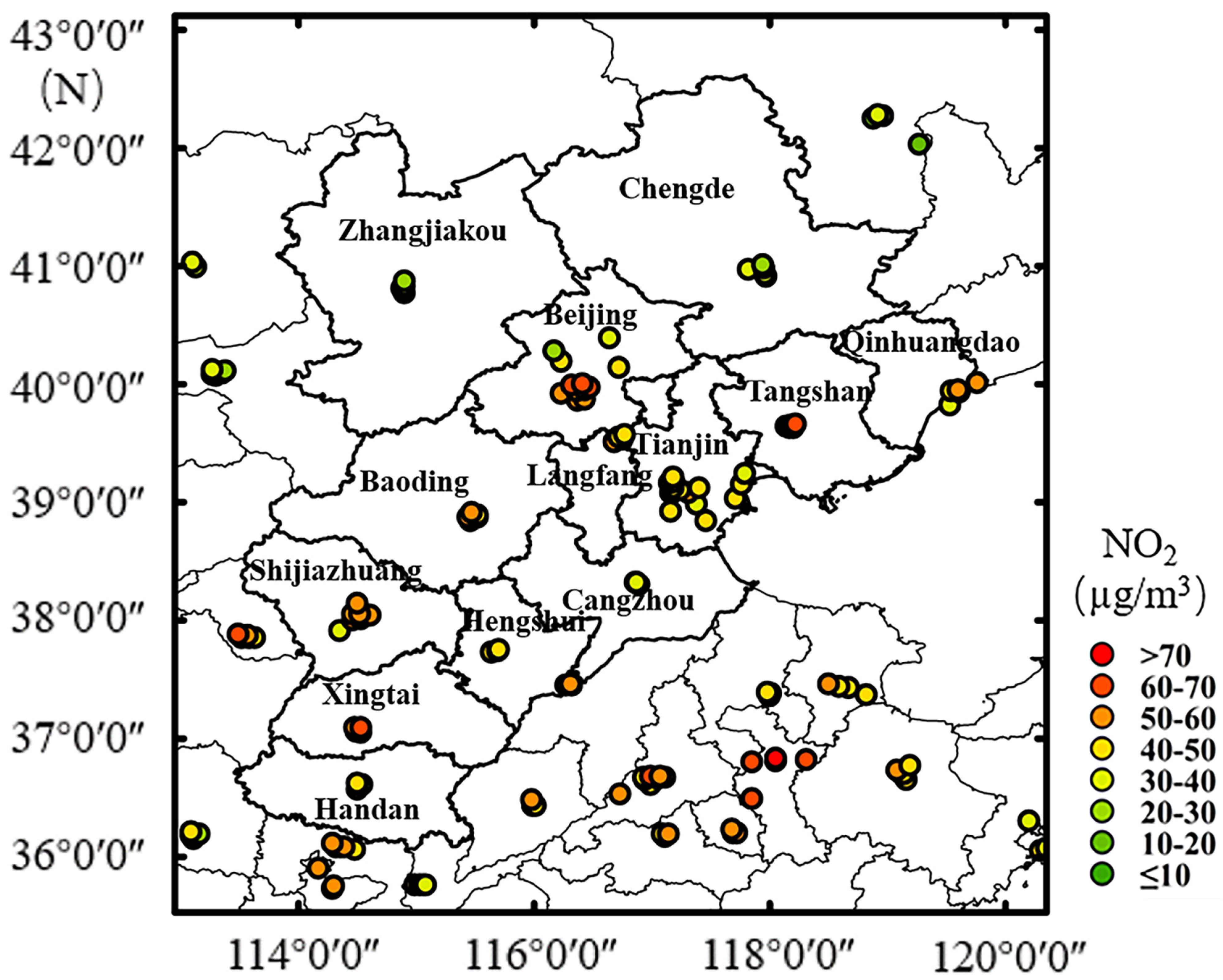
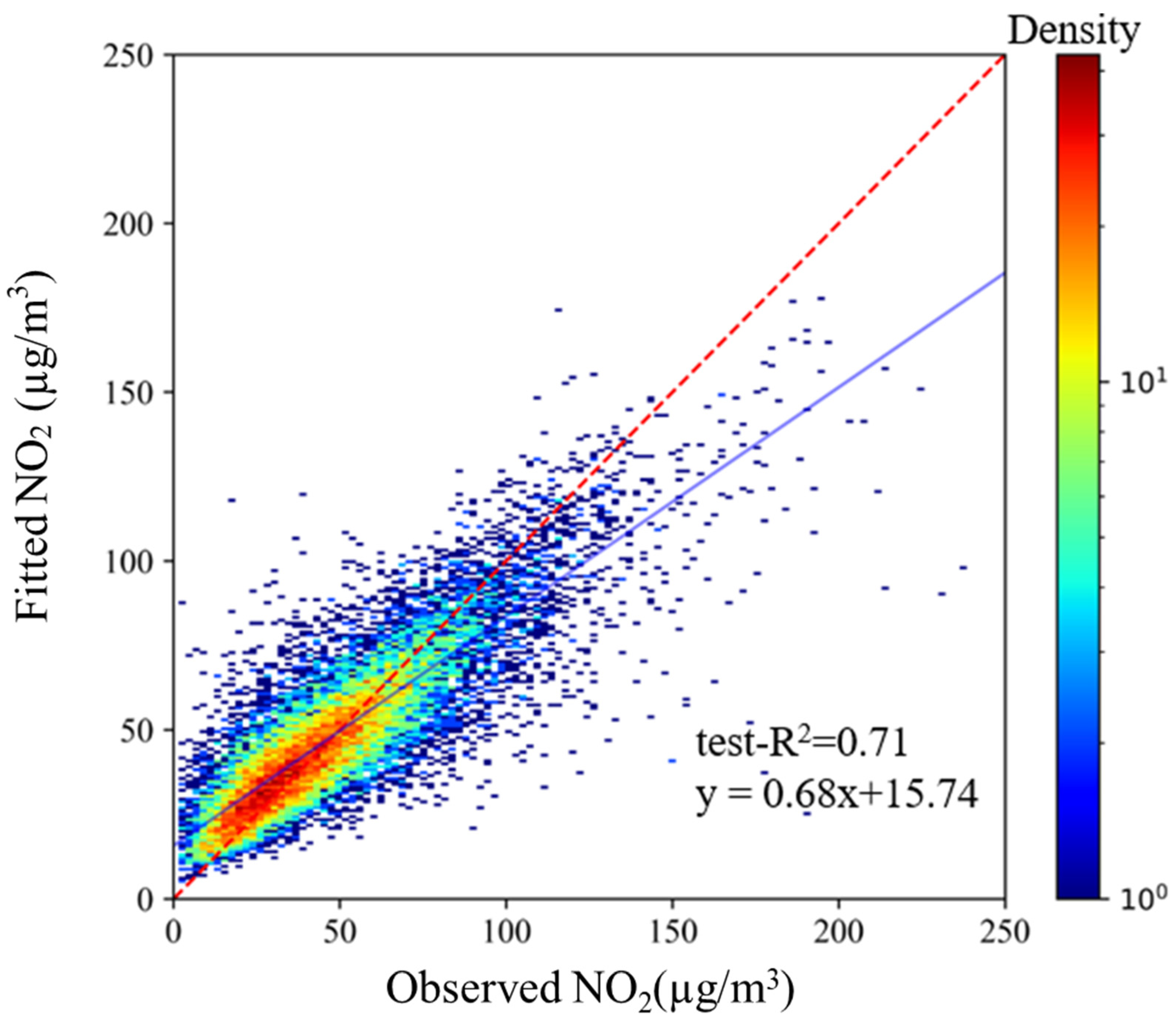
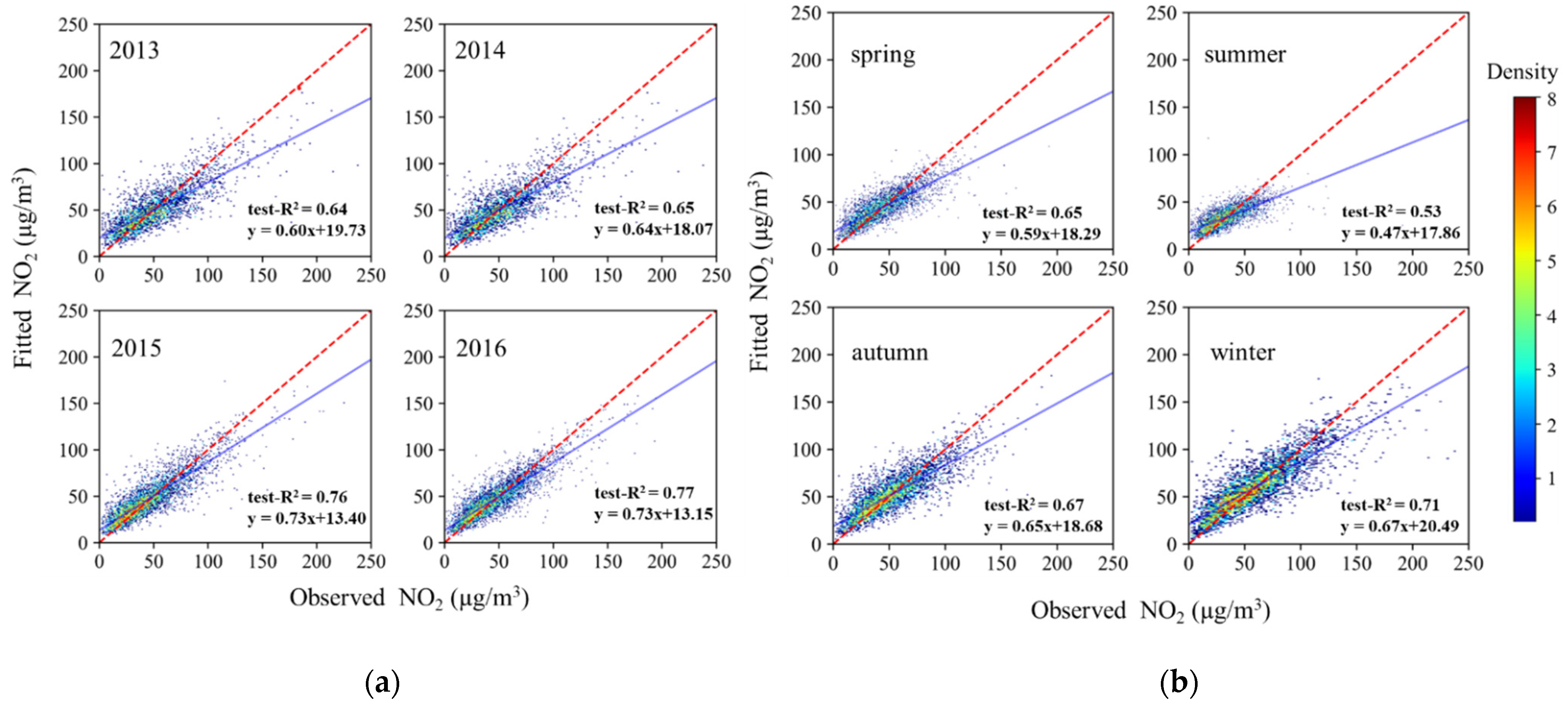
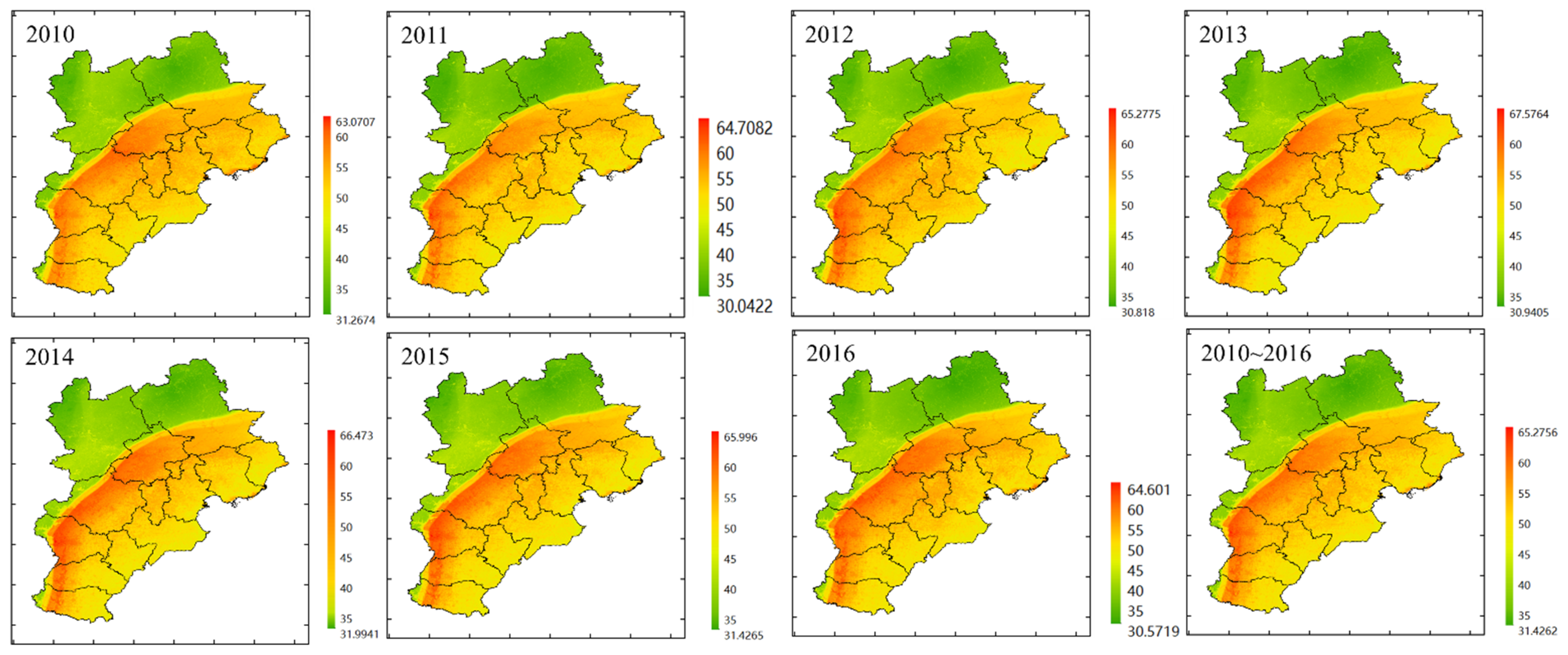
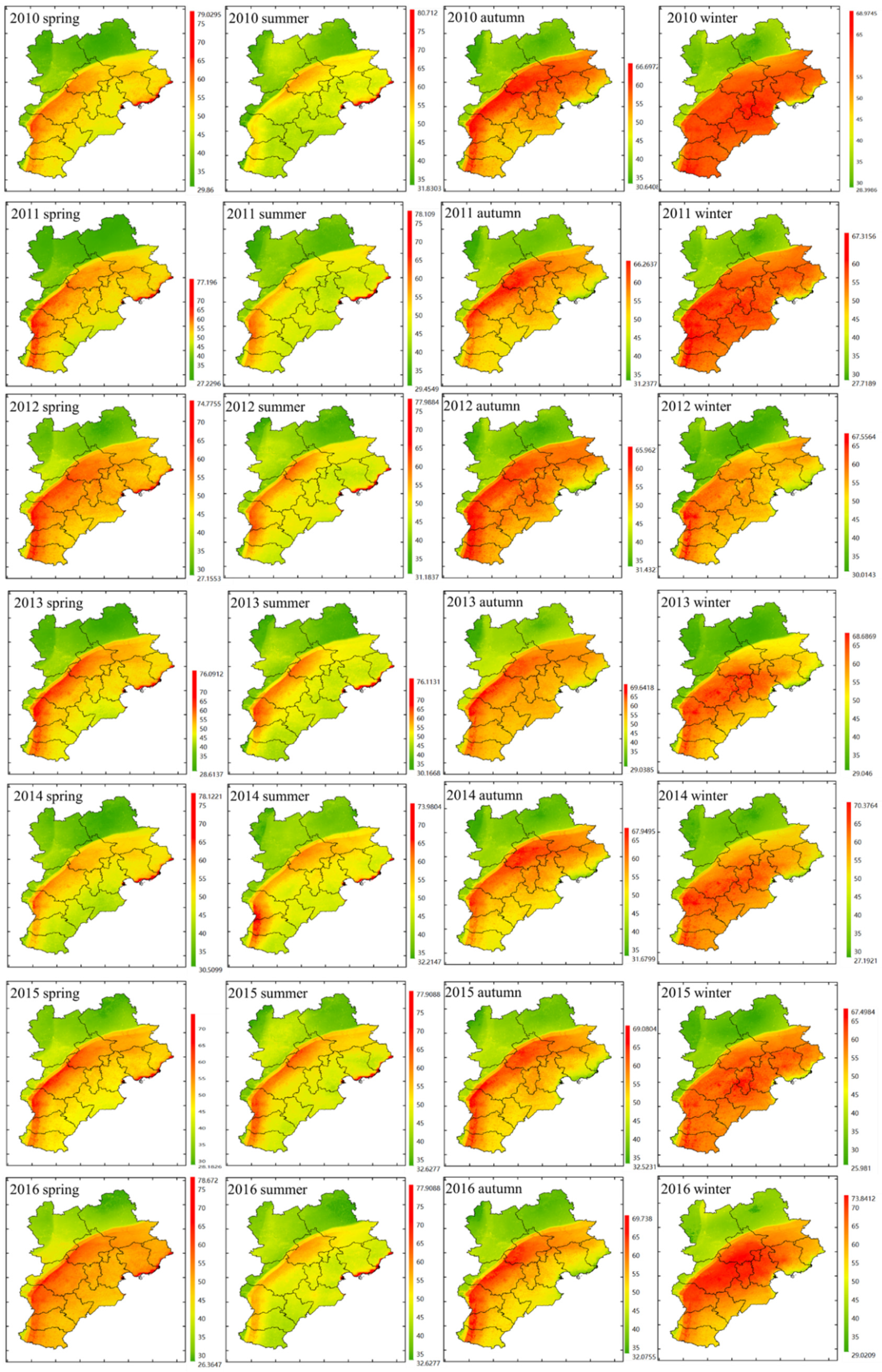
| Province Region | Test-R2 | Test-RMSE (µg/m3) | Test-MAE (µg/m3) | Prefecture-Level City | Test-R2 | Test-RMSE (µg/m3) | Test-MAE (µg/m3) |
|---|---|---|---|---|---|---|---|
| Total | 0.71 | 14.36 | 9.90 | ||||
| Beijing | 0.82 | 11.65 | 8.45 | – | – | – | – |
| Tianjin | 0.77 | 11.91 | 8.76 | – | – | – | – |
| Hebei | 0.72 | 15.14 | 10.33 | Baoding | 0.70 | 17.31 | 11.44 |
| Langfang | 0.58 | 14.19 | 8.66 | ||||
| Shijiazhuang | 0.74 | 16.55 | 11.63 | ||||
| Cangzhou | 0.49 | 17.20 | 9.33 | ||||
| Hengshui | 0.76 | 14.31 | 10.46 | ||||
| Xingtai | 0.78 | 11.38 | 8.41 | ||||
| Handan | 0.45 | 21.15 | 15.23 | ||||
| Zhangjiekou | 0.60 | 11.78 | 7.35 | ||||
| Chengde | 0.66 | 12.09 | 8.26 | ||||
| Qinhuangdao | 0.49 | 15.66 | 11.53 | ||||
| Tangshan | 0.73 | 13.79 | 10.23 |
Publisher’s Note: MDPI stays neutral with regard to jurisdictional claims in published maps and institutional affiliations. |
© 2021 by the authors. Licensee MDPI, Basel, Switzerland. This article is an open access article distributed under the terms and conditions of the Creative Commons Attribution (CC BY) license (http://creativecommons.org/licenses/by/4.0/).
Share and Cite
Pan, Y.; Zhao, C.; Liu, Z. Estimating the Daily NO2 Concentration with High Spatial Resolution in the Beijing–Tianjin–Hebei Region Using an Ensemble Learning Model. Remote Sens. 2021, 13, 758. https://doi.org/10.3390/rs13040758
Pan Y, Zhao C, Liu Z. Estimating the Daily NO2 Concentration with High Spatial Resolution in the Beijing–Tianjin–Hebei Region Using an Ensemble Learning Model. Remote Sensing. 2021; 13(4):758. https://doi.org/10.3390/rs13040758
Chicago/Turabian StylePan, Yanding, Chen Zhao, and Zhaorong Liu. 2021. "Estimating the Daily NO2 Concentration with High Spatial Resolution in the Beijing–Tianjin–Hebei Region Using an Ensemble Learning Model" Remote Sensing 13, no. 4: 758. https://doi.org/10.3390/rs13040758
APA StylePan, Y., Zhao, C., & Liu, Z. (2021). Estimating the Daily NO2 Concentration with High Spatial Resolution in the Beijing–Tianjin–Hebei Region Using an Ensemble Learning Model. Remote Sensing, 13(4), 758. https://doi.org/10.3390/rs13040758



